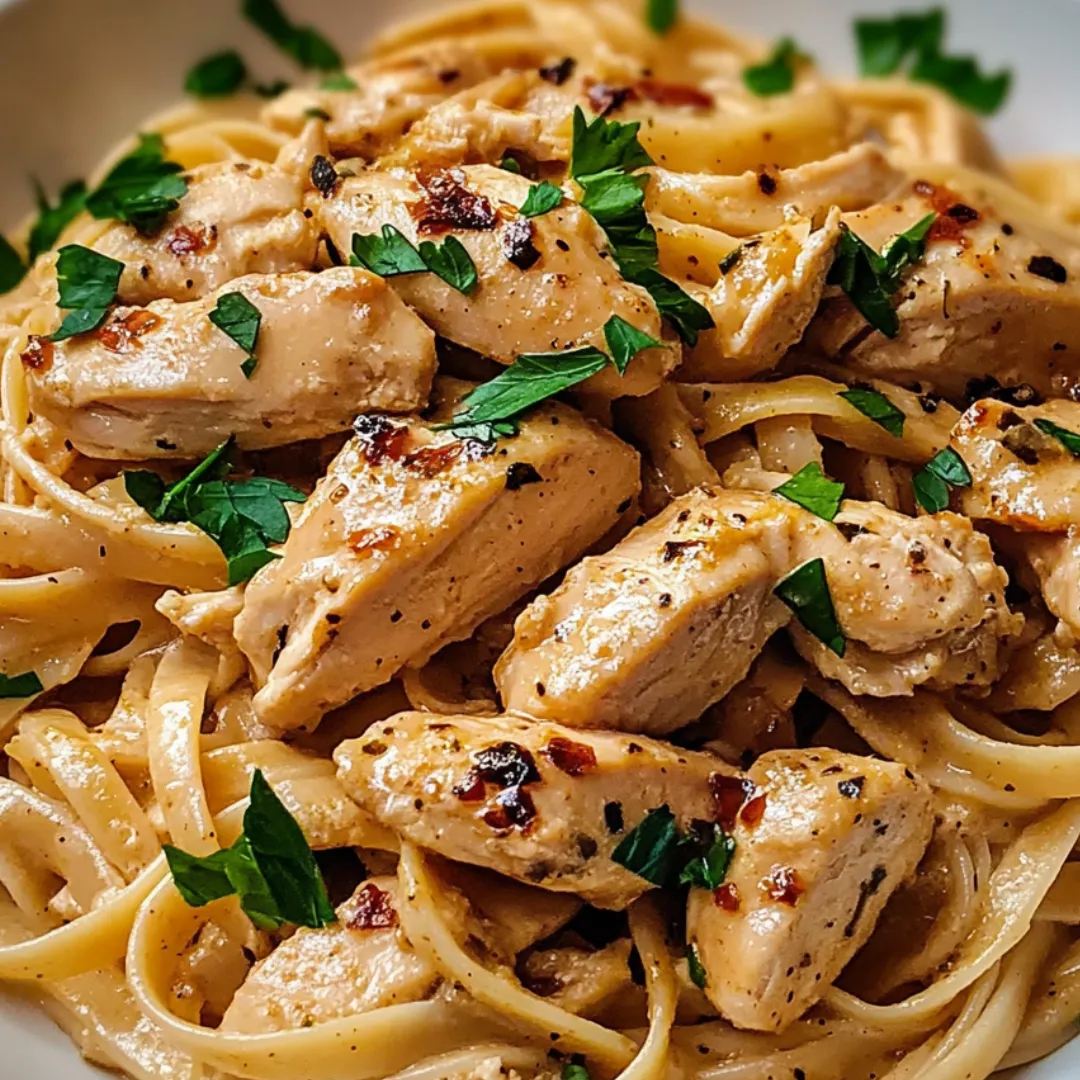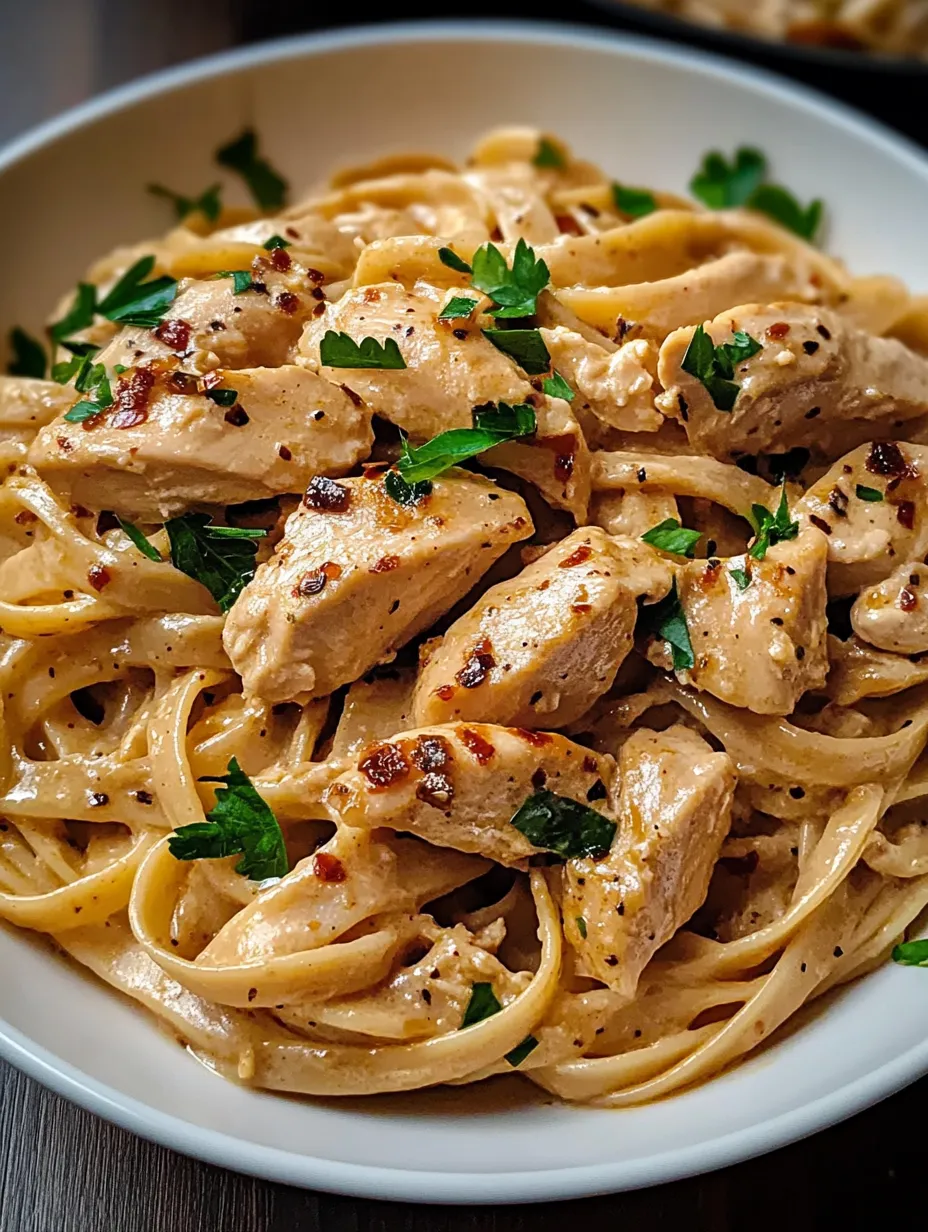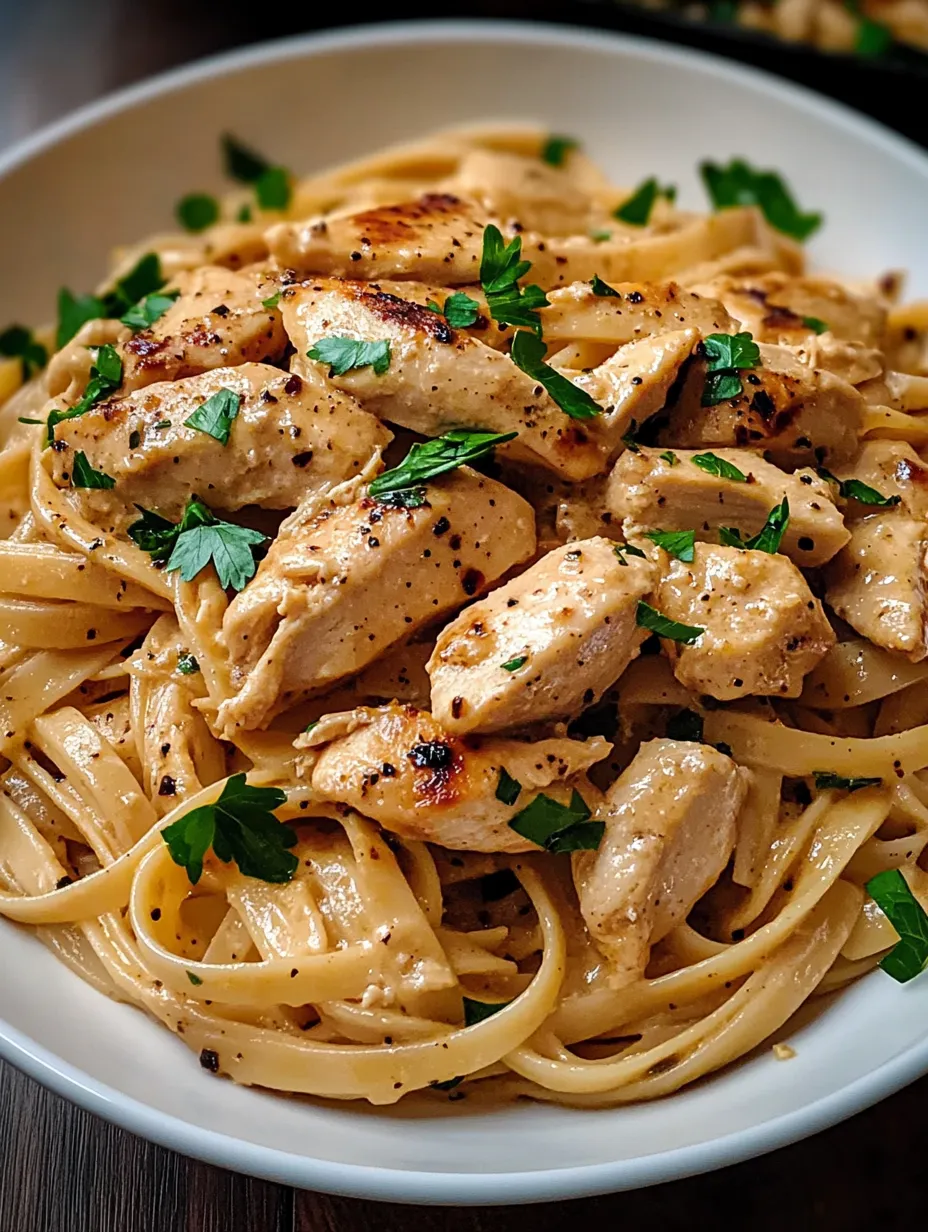 Pin it
Pin it
Cowboy Butter Chicken Linguine transforms ordinary pasta night into something truly extraordinary with minimal effort. The magic happens when tender chicken meets a silky-smooth, herb-infused butter sauce that coats every strand of linguine with indulgent flavor. Unlike traditional pasta dishes that rely heavily on cream or tomatoes, this recipe centers around a spice-flecked, lemon-brightened butter sauce that delivers complexity without heaviness. The result is a perfectly balanced dish with just enough richness to feel special, while the fresh herbs and zesty elements keep it from becoming overwhelming. Ready in just 30 minutes but tasting like it took hours, this dish proves that weeknight cooking can be both practical and spectacular.
I discovered this recipe during a particularly hectic week when I was desperately seeking something new to break our dinner rut without requiring a special shopping trip. The first time I made it, my kitchen filled with the most enticing aroma of butter, herbs, and garlic. My husband, who generally offers polite but minimal commentary on dinner, actually stopped mid-bite to ask, 'What is IN this sauce?' After that night, it became our go-to for everything from last-minute company to comfort food cravings. I've since made it dozens of times, tweaking the spice level and ingredients based on what's in my pantry, and it never disappoints.
Essential Ingredients
- Boneless, Skinless Chicken Breasts: The protein foundation of the dish, providing lean meat that becomes tender and flavorful when properly seasoned and cooked. Cutting into uniform cubes ensures even cooking and perfect bite-sized pieces that integrate well with the pasta. For maximum juiciness, avoid overcooking - chicken should reach 165°F but not much higher.
- Linguine Pasta: This flat, thin noodle is slightly wider than spaghetti, offering the perfect surface area to capture the buttery sauce. The ribbon-like shape stands up well to the substantial chicken pieces while remaining delicate enough to twirl elegantly around your fork. Cook just until al dente - it will continue softening slightly when tossed with the hot sauce.
- Butter: The heart of the cowboy butter sauce, providing richness and serving as the vehicle for all the herbs and spices. Use unsalted to control the sodium level, and ensure it's at room temperature when creating the compound butter for the smoothest integration of flavors. European-style butter with higher butterfat content creates an even more luxurious result.
- Fresh Parsley: Adds bright color and a fresh, herbaceous note that cuts through the richness of the butter. The slight pepperiness of flat-leaf (Italian) parsley works particularly well in this dish, though curly parsley can substitute in a pinch. Chop just before using to preserve the volatile oils that contain much of the herb's flavor.
- Lemon Juice: Provides essential acidity that balances the richness of the sauce and prevents the dish from becoming too heavy. Fresh is non-negotiable here - bottled lemon juice lacks the bright, complex flavor of freshly squeezed. The citrus notes wake up all the other flavors in the dish.
- Dijon Mustard: A secret ingredient that adds depth without announcing its presence obviously. The sharp, tangy notes enhance the sauce without making it taste 'mustardy,' while the natural emulsifiers in mustard help create a smooth, cohesive sauce. Look for authentic Dijon rather than yellow mustard for the best flavor.
- Red Pepper Flakes: Brings a subtle heat that builds gently rather than overwhelming. This warming spice element balances the richness of the butter and brightens the entire dish. Adjust the amount based on your heat preference - even a small amount adds character without making the dish truly spicy.
 Pin it
Pin it
Step-by-Step Cooking Instructions
- Prepare Your Mise en Place:
- Begin by organizing all ingredients before heat touches pan. Cut 2 boneless, skinless chicken breasts into even 1-inch cubes for consistent cooking. Measure out your spices: 1 teaspoon garlic powder, 1 teaspoon onion powder, 1/2 teaspoon smoked paprika, and 1/4 teaspoon cayenne pepper (if using). Chop 2 tablespoons fresh parsley, squeeze 1 tablespoon fresh lemon juice, and have all remaining ingredients within arm's reach. This preparation ensures a smooth cooking process without the panic of searching for ingredients while something burns.
- Season and Cook the Chicken:
- In a medium bowl, toss the chicken cubes with garlic powder, onion powder, smoked paprika, cayenne (if using), and a generous pinch of salt and pepper. Ensure each piece is evenly coated for maximum flavor development. Heat 1 tablespoon olive oil and 1 tablespoon butter in a large skillet over medium-high heat until the butter is melted and begins to foam. Add the seasoned chicken in a single layer, being careful not to overcrowd the pan. Allow the chicken to cook undisturbed for 3-4 minutes to develop a golden crust, then flip and cook for another 3-4 minutes until completely cooked through. The chicken should be golden on the outside and reach an internal temperature of 165°F. Transfer to a clean plate, tent loosely with foil to keep warm, and set aside.
- Boil the Pasta:
- While the chicken cooks, bring a large pot of water to a rolling boil. Add a tablespoon of salt (the water should taste like the sea), then add 8 ounces of linguine. Cook according to package directions until al dente, typically 9-11 minutes. Before draining, reserve 1/2 cup of the starchy pasta water—this liquid gold will help create a silky sauce later. Drain the pasta but do not rinse it; the starch on the surface helps the sauce adhere better. Toss with a tiny bit of olive oil if not returning to the sauce immediately to prevent sticking.
- Create the Cowboy Butter Sauce Base:
- Using the same skillet where you cooked the chicken (without washing it—those browned bits are flavor!), reduce heat to medium-low. Add 1/2 cup softened unsalted butter to the pan. As it begins to melt, add 1/4 cup chicken broth and use a wooden spoon to scrape up all the flavorful fond from the bottom of the pan. This deglazing step incorporates the concentrated chicken flavor back into your sauce. Whisk in 1 tablespoon Dijon mustard until completely incorporated, creating an emulsified base for your sauce.
- Enrich and Season the Sauce:
- Pour in 1/4 cup heavy cream and stir to combine, allowing the mixture to simmer gently for 2-3 minutes until it begins to thicken slightly. Add the fresh lemon juice, most of the chopped parsley (reserve some for garnish), and red pepper flakes if using. Stir in 1/4 cup grated Parmesan cheese, which will both flavor and thicken the sauce. If the sauce seems too thick, add a splash of the reserved pasta water to reach your desired consistency. The sauce should coat the back of a spoon but still flow easily—not too thick, not too thin.
- Unite the Components:
- Return the cooked chicken to the skillet, along with any accumulated juices from the plate. Gently fold to coat each piece in the luxurious sauce. Add the drained linguine directly to the skillet, using tongs to toss everything together until every strand is glossy with sauce and the chicken is evenly distributed. If needed, add more reserved pasta water a tablespoon at a time to maintain the silky texture. Allow everything to simmer together for 1-2 minutes so the pasta can absorb some of the sauce and flavors can meld.
- Finish with Flair:
- Remove the skillet from heat and perform one final taste test, adjusting salt and pepper if needed. The flavors should be balanced—buttery, savory, with hints of brightness from the lemon and a gentle warmth from the spices. Transfer to a large serving platter or individual plates, twirling the pasta slightly for height. Sprinkle with the remaining fresh parsley and additional Parmesan cheese. For an elegant touch, add a light dusting of freshly ground black pepper and tiny lemon zest curls using a microplane or zester.
The Art of Sauce Making
The first time I made this dish, I learned an important lesson about butter sauces. I had the heat too high when combining everything, causing the sauce to 'break' and become greasy rather than creamy. Now I always reduce the heat to medium-low before creating the sauce and maintain a gentle simmer rather than a boil. This temperature control ensures the butter emulsifies properly with the other ingredients, creating that luxurious, silky texture that makes this dish so special. I've also discovered that adding the cheese gradually rather than all at once helps it melt smoothly into the sauce without clumping.
The first time I made this dish, I learned an important lesson about butter sauces. I had the heat too high when combining everything, causing the sauce to 'break' and become greasy rather than creamy. Now I always reduce the heat to medium-low before creating the sauce and maintain a gentle simmer rather than a boil. This temperature control ensures the butter emulsifies properly with the other ingredients, creating that luxurious, silky texture that makes this dish so special. I've also discovered that adding the cheese gradually rather than all at once helps it melt smoothly into the sauce without clumping.
Perfect Pairing Suggestions
This luxurious pasta dish deserves thoughtful accompaniments that complement without competing. A simple arugula salad dressed with lemon vinaigrette provides a peppery, refreshing contrast to the rich pasta. The bright acidity cuts through the buttery sauce while the leafy greens add nutritional balance. For bread, consider a crusty baguette or rustic Italian loaf—perfect for capturing any remaining sauce on your plate. If you're serving wine, a crisp Pinot Grigio or unoaked Chardonnay complements the buttery richness while maintaining enough acidity to refresh the palate between bites.
Vegetable Integration Strategies
While delicious as written, this recipe welcomes vegetable additions that transform it into a complete one-dish meal. For leafy greens, add 2 cups of baby spinach during the final minute of cooking—it will wilt perfectly into the sauce without requiring additional cookware. Cherry tomatoes halved and added with the chicken bring bursts of juicy sweetness that complement the rich sauce. For earthier notes, sauté 8 ounces of sliced mushrooms after removing the chicken and before starting the sauce—they'll absorb the chicken flavor and release their own umami richness. Whatever vegetables you choose, ensure they're cut to appropriate sizes for even cooking and harmonious eating.
Make-Ahead Options
While this dish truly shines when freshly made, certain components can be prepared ahead to streamline dinner preparation. The chicken can be seasoned and stored in the refrigerator up to 24 hours in advance, developing even deeper flavor as it marinates in the spices. The compound butter elements (butter, herbs, and seasonings) can be mixed up to three days ahead and refrigerated, though you'll need to bring it to room temperature before using. For meal prep, consider cooking all components but storing them separately—reheat the chicken and sauce gently on the stovetop, cooking fresh pasta just before serving for the best texture and flavor experience.
Leftover Renaissance
Should you find yourself with leftovers, proper reheating is crucial to maintaining the dish's integrity. Add a splash of chicken broth or cream when rewarming over medium-low heat to restore the sauce's silky consistency. For a complete transformation, turn leftovers into a new meal by adding 1/2 cup of chicken broth to create a pasta soup, or toss with halved cherry tomatoes and cubed mozzarella for a cold pasta salad version. The flavors actually develop overnight, sometimes making the second-day experience even more flavorful, though the pasta texture will be softer.
 Pin it
Pin it
Dietary Adaptations
This versatile recipe accommodates various dietary needs with thoughtful substitutions. For a gluten-free version, simply swap the linguine for your favorite gluten-free pasta, adjusting cooking time according to package directions. Those avoiding dairy can replace butter with a high-quality plant-based alternative and use coconut cream instead of heavy cream, though the flavor profile will shift slightly toward the tropical. For increased protein or a carb-conscious approach, double the chicken and reduce the pasta by half, creating a chicken-forward dish with just enough pasta to satisfy the craving without dominating the plate.
This Cowboy Butter Chicken Linguine has become my signature dish for both family dinners and casual entertaining. There's something about the combination of familiar comfort food elements elevated with that special butter sauce that makes people feel simultaneously nurtured and impressed. What began as a simple weeknight experiment has evolved into the recipe friends text me for after dinner parties and the one my teenagers request when they bring friends home. The beauty lies in its versatility—elegant enough for company but easy enough for Monday night, rich-tasting without being heavy, and traditional enough to please everyone while still offering something excitingly different from the usual pasta routine.
Frequently Asked Questions
- → What makes this cowboy butter sauce different?
- Cowboy butter combines butter with herbs, spices, and a hint of heat for a rich, zesty flavor that elevates simple dishes like chicken and pasta.
- → Can I make this ahead of time?
- The sauce can be made ahead and stored in the refrigerator. When ready to eat, reheat gently and toss with freshly cooked pasta and chicken.
- → Is there a lighter version of this recipe?
- You can use half-and-half instead of heavy cream and reduce the butter by half. It won't be quite as rich but still delicious.
- → What sides go well with this pasta?
- A simple green salad, garlic bread, or roasted vegetables make perfect accompaniments to balance the richness of the pasta.
- → Can I use a different pasta shape?
- Absolutely! Fettuccine, spaghetti, or even penne work well. Choose a pasta that holds sauce well for the best results.
